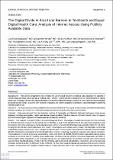| dc.description.abstract | Background
The COVID-19 pandemic has increased the use of digital solutions in medical care, especially for patients in remote areas and those requiring regular medical care. However, internet access is essential for the implementation of digital health care. The digital divide is the unequal distribution of access to digital technology, and the first level digital divide encompasses structural barriers. Brazil, a country with economic inequality and uneven population distribution, faces challenges in achieving internet access for all.
Objective
This study aims to provide a comprehensive overview of the first-level digital divide in Brazil, estimate the relationship between variables, and identify the challenges and opportunities for digital health care implementation.
Methods
Data were retrieved from the Brazilian Institute of Geography and Statistics National Continuous House survey database, including demographic, health, and internet-related variables. Statistical analysis included 2-tailed t tests, chi-square, and multivariate logistic regression to assess associations between variables.
Results
Our analysis included 279,382 interviews throughout Brazil. The sample included more houses from the northeast (n=99,553) and fewer houses from the central west (n=30,804). A total of 223,386 (80.13%) of the interviewed population used the internet, with urban areas having higher internet access (187,671/212,109, 88.48%) than rural areas (35,715/67,077, 53.24%). Among the internet users, those interviewed who lived in urban houses, were women, were younger, and had higher income had a statistically higher prevalence (P<.001). Cell phones were the most common device used to access the internet (141,874/143,836, 98.63%). Reasons for not using the internet included lack of interest, knowledge, availability, and cost, with regional variations. The prevalence of internet access also varied among races, with 84,747 of 98,968 (85.63%) White respondents having access, compared to 22,234 of 28,272 (78.64%) Black respondents, 113,518 of 148,191 (76.6%) multiracial respondents, and 2887 of 3755 (76.88%) other respondents. In the southeast, central west, and south regions, the numbers of people with internet access were 49,790 of 56,298 (88.44%), 27,209 of 30,782 (88.39%), and 27,035 of 31,226 (86.58%), respectively, and in the north and northeast, 45,038 of 61,404 (73.35%) and 74,314 of 99,476 (74.7%). The income of internet users was twice the income of internet nonusers. Among those with diabetes-related limitations in daily activities, 945 of 2377 (39.75%) did not have internet access, and among those with daily activity restrictions, 1381 of 3644 (37.89%) did not have access. In a multivariate logistic regression analysis, women (odds ratio [OR] 1.147, 95% CI 0.118-0.156; P<.001), urban households (OR 6.743, 95% CI 1.888-1.929; P<.001), and those earning more than the minimum wage (OR 2.087, 95% CI 0.716-0.756; P<.01) had a positive association with internet access.
Conclusions
Brazil’s diverse regions have different demographic distributions, house characteristics, and internet access levels, requiring targeted measures to address the first-level digital divide in rural areas and reduce inequalities in digital health solutions. Older people, poor, and rural populations face the greatest challenges in the first level digital divide in Brazil, highlighting the need to tackle the digital divide in order to promote equitable access to digital health care. | en_US |
